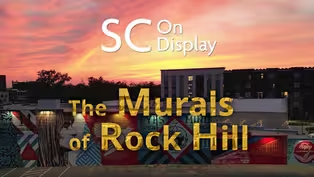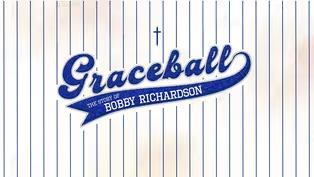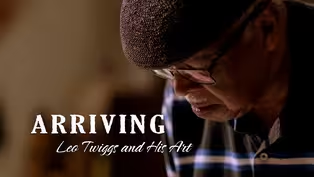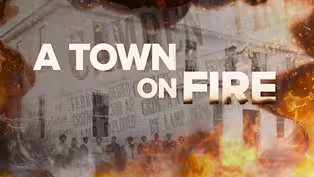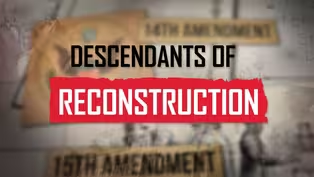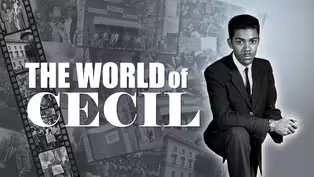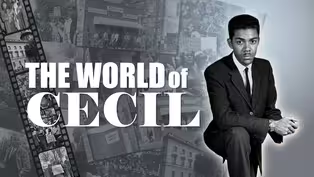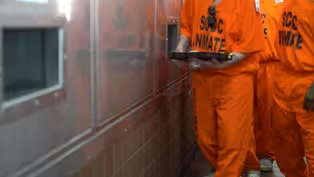
Front Porch Carolinas
Special | 27m 2sVideo has Closed Captions
Front Porch Carolinas takes viewers to important Civil Rights locations in the state.
This special takes viewers to locations that played pivotal roles in both the Civil Rights movement and South Carolina’s broader history.
Problems playing video? | Closed Captioning Feedback
Problems playing video? | Closed Captioning Feedback
SCETV Specials is a local public television program presented by SCETV
Support for this program is provided by The ETV Endowment of South Carolina.

Front Porch Carolinas
Special | 27m 2sVideo has Closed Captions
This special takes viewers to locations that played pivotal roles in both the Civil Rights movement and South Carolina’s broader history.
Problems playing video? | Closed Captioning Feedback
How to Watch SCETV Specials
SCETV Specials is available to stream on pbs.org and the free PBS App, available on iPhone, Apple TV, Android TV, Android smartphones, Amazon Fire TV, Amazon Fire Tablet, Roku, Samsung Smart TV, and Vizio.
More from This Collection
Find content produced by SCETV.
Weathering The Flood: South Carolina 10 Years Later
Video has Closed Captions
Revisit the "thousand-year" flood of October 2015. (26m 46s)
SC On Display: The Murals of Rock Hill
Video has Closed Captions
"'The Murals of Rock Hill'' spotlights this vibrant art community. (26m 46s)
Graceball: The Story of Bobby Richardson
Video has Closed Captions
At nineteen years-old, Bobby Richardson, became the starting second baseman for the Yankees. (54m 51s)
Arriving: Leo Twiggs and His Art
Video has Closed Captions
Dr. Leo Twiggs is an artist and educator in South Carolina. (56m 46s)
Video has Closed Captions
The Cleveland School fire of 1923 influenced building and fire codes nationwide. (56m 46s)
Video has Closed Captions
Explore the relationship between Reconstruction and African American Life. (56m 46s)
Video has Closed Captions
Part two continues the examination of the life of Cecil Williams. (56m 46s)
Video has Closed Captions
Explore the life of acclaimed civil rights photographer, Cecil J. Williams. (57m)
A Conversation With Will Willimon
Video has Closed Captions
William Willimon is an American theologian and bishop in the United Methodist Church. (27m 46s)
Carolina Country with Patrick Davis & Friends
Video has Closed Captions
Carolina Country with Patrick Davis & Friends. (58m 39s)
Providing Support for PBS.org
Learn Moreabout PBS online sponsorship♪ Narrator> The state of South Carolina has a rich and vibrant history that spans centuries.
The generations of families that have called this state home are all part of the intricately woven fabric that has made South Carolina what it is today.
So let's take a trip to four regions essential to any discussion of South Carolina history.
First stop, Beaufort to visit the Mather School, which was established in 1868 to provide education to children of formerly enslaved people.
Then on to the Sumter County Museum, which is actually a complex of several smaller museums that depict different eras of life in South Carolina.
Next, a visit to the historic home of Benjamin Mays, a civil rights leader who was a role model and advisor to Dr. Martin Luther King Jr and is credited with laying the intellectual foundations of the non-violent American Civil Rights Movement.
And lastly, we visit Rock Hill, where we'll meet Chef Rob Masone, owner of Kounter Restaurant, the location of the 1961 lunch counter sit in, made famous by the Friendship Nine.
♪ ♪ First up, the Mather School in Beaufort.
♪ ♪ ♪ >> I found a lady by the name of Rachel Crane Mather, who lived in Boston at the time, got a commission from the American Missionary Association.
There was a group of, I want to call them philanthropists.
And they were a religious organization that went all around the LowCountry southeast, founding Black schools and colleges after the Civil War, especially.
So when she got to Beaufort and she saw this mass of homeless children roaming around with no direction, she felt like they needed more than a school.
They needed a home.
♪ Rachel severed her ties with the American Missionary Association, took $87 of her own money and bought 20 acres of land, this beautiful campus that we are sitting on now and founded the Mather School.
And that was, 1868.
♪ She first bought the property.
There wasn't any, there was only one building on the property.
But, Rachel was able to buy a couple of empty buildings on Hilton Head that the Union Army and Navy had abandoned.
And they floated those buildings on a raft down the river, this Beaufort River.
And they put those buildings in the parking lot over here.
And they became the first couple of buildings that was on this campus.
That was right after that was around 1869, I imagine.
So through the years, the girls learned how to do a lot of domestic work that allowed them to be employable in years to come.
And that, that lasted until 1968, which was the year I came.
Well, I came in 1967, and the school shut down in 1968.
So I was only here one year.
♪ ♪ ♪ Well, you know, I grew up in a little town called Sheldon, which is only like 20 miles from here.
But, we had a little small farm, and I was the oldest child.
So my dad relied on me to do most of the work on that farm.
So when I came to Mather, that was my first time leaving home, although it was just right down the road.
And it was a different experience to come to a place, and you had your own room and your own bed, because when I was home me and my two brothers, we slept in the same bed.
But when I got to Mather, I had my own bed, and I met so many friends on campus that one year.
It was like a family atmosphere because kids were from all over the United States.
And when...you met friends and kids on campus, you became attached.
And, and although it's been 60 something years later, I'm still in contact with a lot of the friends I met in that one year.
I wish I could have gone to Mather for four years, really.
♪ We had no idea in 1967 that the school was going to shut down, a year later.
♪ They were having a hard time competing with a lot of the public schools and colleges in the area.
So, they decided that they would shut down and allow Mather to transition into a trade school.
And it became a part of the technical colleges of the LowCountry.
T.C.L.
has done a wonderful job.
I know about 70,000 students that have come through this campus since it became T.C.L.
And right now today, you could find any job, craft, or any field of employment is right here at T.C.L.
So they have done a marvelous job of continuing the trend of education, affordable education.
We continue to honor Mather, right and celebrate Mather School.
This building that we are sitting in front of is called the Mather Museum and Interpretive Center.
And the Technical College of the LowCountry has been gracious enough to allow us to transform what used to be our library.
When I was a student, they allowed us to transform this building into a Mather Museum.
♪ And we are open from time to time, especially by appointment, to allow the public to come in.
and just browse around and see what we've collected and we are still in the process of collecting.
We are, we are working in conjunction with the University of South Carolina Beaufort, Technical College of the LowCountry, the National Park Service.
All of those partners are helping us tell the Mather story.
Mather has accumulated a lot of stories in a hundred years, and we are trying to preserve those and recreate some of those and let people that have only heard about Mather and a lot of people haven't heard, let them enjoy what went on, on this campus.
It was a very important Reconstruction Era school.
If it wasn't for Mather, a lot of older "Mather-ites" will tell you, they don't know what they would have done.
♪ It's a worthy institution to be honored, and we just hope that we can do it justice by continuing the legacy of honoring Mather school.
♪ Narrator> Next, we go to the Sumter Museum.
♪ Annie Rivers> We are in the Williams Brice House, which is the main feature of the museum.
It has been our main feature since 1976, when it opened the Williams Brice House itself dates 1916, but there is history.
The house on this site before that, owned by Andrew Jackson Moses and Octavia Harvey Moses.
They came from Charleston.
He was a Jewish merchant, very much involved in the community.
They built a house here in the 1840s.
In that house they had 17 children.
So quite a large family.
The Sumter Museum opened in 1976, and since that time we have been showing period rooms, so you can get a feel of how the house would have appeared in the early 1900s, as well as exhibits.
♪ So we talk about Sumter County history, various topics from military, Native Americans, all sorts of things that we change out regularly.
♪ But we also have several other features, as part of the Sumter Museum campus.
We have the Heritage Education Center, that was added in 2003, where we do a lot of programs both for children and adults.
We have speakers come in.
We do book signings with authors.
We do all sorts of programs for kids of different ages.
We also rent out Mackenzie Hall in that space for weddings and other community events.
♪ So that's a big component of our programs.
♪ And then our major component of our museum campus, a beloved feature by many people in our community, is our Carolina Backcountry Homestead that we added in the late 1990s, in that, we brought two buildings from other places in the county, a settler's house and a commissary, to represent what a one family farm might have looked like in this area of South Carolina around the year 1800.
♪ And then reconstructed other buildings that early settlers might have needed, like a blacksmith shop, a loom house where we have a working weaving loom, as well as spinning wheels, because they didn't have stores to go to.
♪ So our visitors can come walk through those buildings, see all the different artifacts within them, and get a feel for you know what that might have been like.
♪ Families can come out and experience life during a simpler time away from technology, see cooking over the open fire, see blacksmithing.
We have a great group of volunteers that we're very thankful for.
♪ And then in 2018, we added the Temple Sinai Jewish History Center site, which is just down the street from the museum at 11 Church Street.
So visitors can come to all of our facilities, they're all within walking distance.
♪ They reached out to us about installing a permanent exhibit inside their social hall so that we can preserve their building, preserve their history, and also tell the story of the Holocaust, for future generations to see.
We tell the story of Abraham Stern, who was a Holocaust survivor that recently passed away but lived in Sumter for many years and was certainly a beloved member of our community.
♪ Diana Roof> So this is a place that people can come learn about the history of the Jewish people, about the history of the Jewish people here in Sumter, about the holidays that the Jewish people celebrate.
The Jewish community in Sumter started in about 1813, 1815.
And once they got a few families here, they decided that they, wanted somewhere to worship.
So they raised money.
They bought the land that the temple is currently built on, building a small wooden structure here, which looked more like a church at the time, but, and then... they remodeled it to what you see today.
They added the windows that you see around you in those windows were added in 1912.
My most rewarding experience here is actually doing the tours with the children.
The children come into this sanctuary and I, I describe to them about all the windows.
I tell them all the stories, and then I tell them about all the items that are here in the sanctuary.
They don't care that they're Christian, that we're Jewish.
They don't care about that.
All they do is they want to hear the story, and they're just very thrilled to be here.
And that's just very refreshing in this time.
It just makes me feel very welcome when people come in here and they're appreciative of the temple, they're appreciative of what we're trying to teach them.
It's very it's a very rewarding experience.
It's just nice to have people that come that want to learn about the Jewish community and about Sumter, and how Sumter connects with the Jewish community.
(music fades) Narrator> Next, we visit the Benjamin Mays Site in historic Greenwood.
♪ Christopher B. Thomas> Dr. Mays is born in a time, right after the end of Reconstruction, where African-Americans were trying to come up from slavery.
And, many obstacles came in the way of the African-American community that, related to this new established society, that the order of that society, was segregation was the Jim Crow South.
And, Mays is an example of the African-Americans drive to rise up out of slavery.
And one of the key areas, of course, is through education.
Loy E. Sartin> Dr. Mays was born in the Epworth community, August 1st, 1894.
His parents were, born into slavery, Hezekiah Sr. and Louvenia, his mother, Benjamin, was the youngest of, eight children.
There were five boys and three girls.
The boys were James, John, Isaiah, Hezekiah, and Benjamin.
And the girls were Sarah, Mary and Susie.
Dr. Benjamin Mays' birth home, sat on the side of U.S.-178 in their birth community.
It was owned by the Griffith family.
They used it as a barn for hay storage.
And there was about a 20 year effort to secure that home from the family.
And through the efforts of Dr. Larry Jackson, at Lander University and Congressman Bryan Dorn, and the Palmetto Conservation Foundation in Columbia, they were finally successful.
They paid $4,000 for the home and it was moved one evening late at night and sat in the field over here.
♪ And, it was moved in 2004.
It sat there for, from '04 to 2010.
When I became involved, I was fortunate and, to be able to volunteer and to furnish the home ♪ and create the site to look like some of them was living here around 1900, with the yard, clothes line, the well, the garden, the small cotton field that we have.
Dr. Mays' birth home was originally two rooms, and you can see that when you walk into the boys' bedroom, looking back, you can see the outside wall going all the way across.
The front room contains a fireplace, and it serves the other room also, Benjamin Mays' parents room.
It's furnished with old period furniture, many things that were donated.
We've had to buy a few things.
A lot of things were given to us.
And in the, in the main bedroom for his parents, we have some artifacts in there that actually belonged to Dr. Mays, two very, very old prints, color prints on the wall and the mirror over the mantel actually belonged to Dr. Mays.
And, you can see as you go in there where some of the wood in the ceiling has been replaced, but most of the wood inside the home is original.
The Burns Spring School on site, which is a great building.
It was in the Epworth community, and it was, kindly donated by the owner to the site in around 2005, about a year after the home was moved here, and it was called the Brickhouse School because it was close to a brick house.
So they called it the Brickhouse School.
And inside, we have some original handmade desks that were from the old Brewer School in there, and blackboards on the wall that still contains, that contains, some assignments for the children.
The upper grades and the lower grades has a coal stove in there, and we have very few books in there.
We often have, school children going into that school.
And we always kind of point out to the children to think about that environment, no computers, very few books, very little chalk.
And so we just ask the students to visualize if you were there in 1900, like Benjamin Mays, what it would have been like, no modern facilities, coal, heat.
Sometimes teachers would cook peas and beans on the stove and serve them to the students, through the day.
After the school was moved in '04, around '06 or '07 the Benjamin Mays Museum was created and built, and in the front room we show Dr. Mays' life in about 115 professionally framed photographs, chronologically throughout the room, starting with his early life in Greenwood, moving around to high school, Bates College, what he did for those 20 years between graduating from college and becoming president of Morehouse College in 1940.
Four years later, in 1944, Dr. Martin Luther King Jr. entered that college as a 15 year old high school 10th grader.
And, he was very close to Dr. King.
Mentored him.
We, we have some great photographs of him delivering the eulogy at Dr. Martin Luther King's funeral.
Dr. Mays was an advisor to three U.S. presidents, President Kennedy, President Johnson, and President Carter.
He was close to all those men.
He was particularly close to President Kennedy.
He said few men in America have I admired as much as John Fitzgerald Kennedy.
♪ Christopher B. Thomas> Mays understood, what social justice was about.
He, framed it, intellectually, both for himself, later for his students.
And I think if Mays made any tremendous contribution to American life, it was, drawing this cadre of young leaders, into, what becomes a civil rights movement, but at the time, Mays was drawing them in to this idea, of social justice.
Mays is at the center of them all.
He is an executive director.
He's a leader in some capacity of all these movements.
And he shapes and defines, their tenor, their character, their ideas.
And because of that, he's considered the principal founder of the Civil Rights Movement.
I think our side is important because it is a site that, not just talks about African-American history, but talks about one of the most significant groups of people, that triumphed and overcame in American life.
The place where this, campus sits is on hallowed ground for African-Americans in Greenwood County.
Right, if you looked from our museum, that building you see there, it's the offices of GLEAMNS, but that was once, Brewer Hospital.
It was the first segregated hospital for Blacks.
My father, grandfather were born in that hospital.
The other side was Brewer School, and it was the segregated school.
And so this was the center of Black life, in Greenwood for a long time.
GLEAMNS is a community action agency.
We run our local Headstart programs.
We run, a workforce development program.
We run a weatherization program.
And, we are here to assist the community to, to very much like Mays, to build people.
♪ Narrator> And finally, we go to the Kounter Restaurant in Rock Hill.
Chef Rob Masone> My name is Chef Rob Masone I am a native of Rock Hill, South Carolina.
And in 2020, after a super successful career in the culinary arts field, all over the country, I decided to come back home and, you know, where my roots were, and, open Kounter.
♪ I grew up going to church about an eighth of a mile from here.
So we had always known about the history of the Friendship Nine.
♪ We were in the demo phase, and I remember I personally took apart the facade, took apart the side of the bar and, and lifted up the top, and I could see an old dusty pink formica top.
And I was like, whoa, this is, this is actually the original counter top that was here.
I literally left the nail holes and the coffee rings and the stains on the counter, and I knew that we were never going to cover that thing up again.
♪ When I first originally saw the countertop in its raw form, I guess it was a, a rush of emotion that, that this is actually a super cool piece of history, but I think we really just wanted to showcase it.
And I'm a firm believer that if we don't continue to talk about all the bad things and just about history in general, then history tends to repeat itself, and we sure don't need that going on anymore.
♪ This is something that is so much bigger than us, and we're just very happy that we have the distinct privilege, really, to continue to talk about it.
So that's kind of built into our culture here at Kounter, we line the seats, we turn them the same direction towards the door every night.
And it's very simply because those seats are always facing the door for those gentlemen to be able to come in this door.
Some of them are with us still and some of them are not, but they're always facing that door.
♪ I was introduced to Mr. Williamson from Visit York County, actually, and we sat in here at the counter, and when we sat down, it was like sitting there talking to my grandfather.
And we talked for like 45 minutes.
We talked about fishing.
We talked about the weather.
We talked about just life, in general.
But the entire time that we were hanging out and we were having this conversation, just rubbing his hand the whole time on that countertop, and that's when the light bulb went off for me.
And I was like, we're not covering this back up, because I saw how moving it was for him to see it after all those years, just raw and exposed.
And I can only imagine what went through his head.
♪ David Williamson Jr.> Before they had to counters all up, this wasn't exposed, and when I seen this and I realized that this was like the original.
And that's when it, it dawned on me, this is the same counter.
This is the same place.
♪ In 1961, when we sat down we weren't there long enough to really, you know, visualize, or even touch it.
So, as soon as you sit down, they arrested you right there.
One thing that was on my mind, I knew I was going to get arrested, but the way they treated you, the way they snatched you up, and grab you and slam you in the doors, I wasn't expecting that.
And then after we went to court, the guy hadn't told me we were going to go to jail.
So that was my big surprise when they said, we were going to do the 30 days.
♪ We went to jail the 31st, went to court on February 1st, and we got out of jail on March the 2nd.
But as far as changes downtown, none of that changed.
And so, we had to continually start protesting in.
And wherever there was a restaurant that wouldn't serve us, that's where we would go.
♪ "The jail, no bail", galvanized the movement, because before that, you know, it was kind of stagnant and stale and, and seeing it wasn't making no progress.
And Rock Hill played a great part in that because we were willing to make that sacrifice.
I didn't leave home to do that, but it was for a reason.
So, a good reason.
That's why, now, when you reflect back then, and you wander was it all worth it.
You know, and even know now that it was People say, well, nobody knows anything about you.
You did.
You didn't do it for notoriety or nothing like that.
You did it to try to bring about change.
♪ Well, the Kounter means that we will always know a part of Rock Hill history.
One of the greatest part of it, one, it was trying to change and make a difference by improving and making progress towards a future.
♪ Chef Rob> Rock Hill to me is, it's family.
It's friends.
It's deep.
The people that are behind the scenes making this city tick and grow, they actually care.
David> One thing I would like to tell people don't go back, go forward.
Make sure you looking out for each other.
You know, everybody is your neighbor, you know.
And if you mistreat me, you just mistreating your neighbor.
And if I don't even live next door to you, I still am your neighbor.
You know, we're in this town together.
We should be one and with the same goal that everybody be treated equally and fairly.
♪ ♪ ♪
Support for PBS provided by:
SCETV Specials is a local public television program presented by SCETV
Support for this program is provided by The ETV Endowment of South Carolina.

